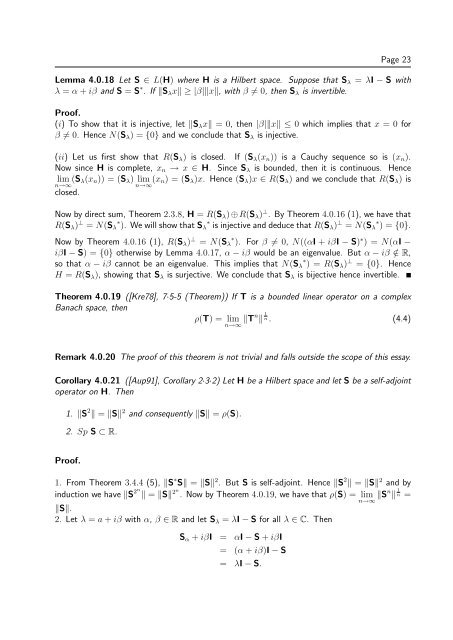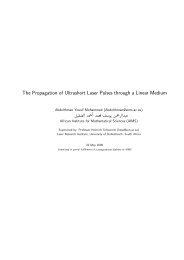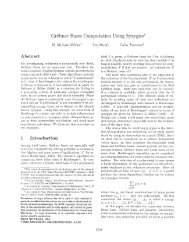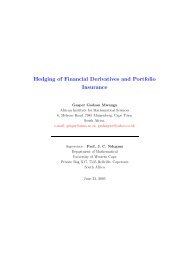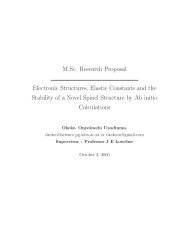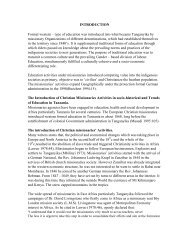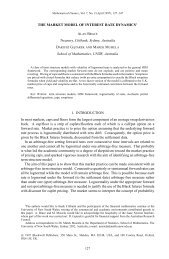Operators on Hilbert Spaces - user web page - AIMS
Operators on Hilbert Spaces - user web page - AIMS
Operators on Hilbert Spaces - user web page - AIMS
Create successful ePaper yourself
Turn your PDF publications into a flip-book with our unique Google optimized e-Paper software.
Page 23<br />
Lemma 4.0.18 Let S ∈ L(H) where H is a <strong>Hilbert</strong> space. Suppose that Sλ = λI − S with<br />
λ = α + iβ and S = S ∗ . If Sλx ≥ |β|x, with β = 0, then Sλ is invertible.<br />
Proof.<br />
(i) To show that it is injective, let Sλx = 0, then |β|x ≤ 0 which implies that x = 0 for<br />
β = 0. Hence N(Sλ) = {0} and we c<strong>on</strong>clude that Sλ is injective.<br />
(ii) Let us first show that R(Sλ) is closed. If (Sλ(xn)) is a Cauchy sequence so is (xn).<br />
Now since H is complete, xn → x ∈ H. Since Sλ is bounded, then it is c<strong>on</strong>tinuous. Hence<br />
lim<br />
n→∞ (Sλ(xn)) = (Sλ) lim (xn) = (Sλ)x. Hence (Sλ)x ∈ R(Sλ) and we c<strong>on</strong>clude that R(Sλ) is<br />
n→∞<br />
closed.<br />
Now by direct sum, Theorem 2.3.8, H = R(Sλ) ⊕ R(Sλ) ⊥ . By Theorem 4.0.16 (1), we have that<br />
R(Sλ) ⊥ = N(Sλ ∗ ). We will show that Sλ ∗ is injective and deduce that R(Sλ) ⊥ = N(Sλ ∗ ) = {0}.<br />
Now by Theorem 4.0.16 (1), R(Sλ) ⊥ = N(Sλ ∗ ). For β = 0, N((αI + iβI − S) ∗ ) = N(αI −<br />
iβI − S) = {0} otherwise by Lemma 4.0.17, α − iβ would be an eigenvalue. But α − iβ /∈ R,<br />
so that α − iβ cannot be an eigenvalue. This implies that N(Sλ ∗ ) = R(Sλ) ⊥ = {0}. Hence<br />
H = R(Sλ), showing that Sλ is surjective. We c<strong>on</strong>clude that Sλ is bijective hence invertible.<br />
Theorem 4.0.19 ([Kre78], 7·5-5 (Theorem)) If T is a bounded linear operator <strong>on</strong> a complex<br />
Banach space, then<br />
ρ(T) = lim T<br />
n→∞ n 1<br />
n . (4.4)<br />
Remark 4.0.20 The proof of this theorem is not trivial and falls outside the scope of this essay.<br />
Corollary 4.0.21 ([Aup91], Corollary 2·3·2) Let H be a <strong>Hilbert</strong> space and let S be a self-adjoint<br />
operator <strong>on</strong> H. Then<br />
1. S 2 = S 2 and c<strong>on</strong>sequently S = ρ(S).<br />
2. Sp S ⊂ R.<br />
Proof.<br />
1. From Theorem 3.4.4 (5), S ∗ S = S 2 . But S is self-adjoint. Hence S 2 = S 2 and by<br />
inducti<strong>on</strong> we have S 2n<br />
= S2n . Now by Theorem 4.0.19, we have that ρ(S) = lim S<br />
n→∞ n 1<br />
n =<br />
S.<br />
2. Let λ = a + iβ with α, β ∈ R and let Sλ = λI − S for all λ ∈ C. Then<br />
Sα + iβI = αI − S + iβI<br />
= (α + iβ)I − S<br />
= λI − S.


